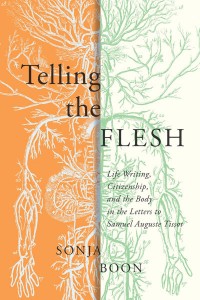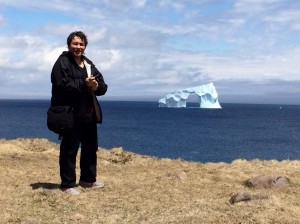“I am the girl in the back. The quiet brown one in a sea of white. There’s another brown girl next door in the brown teacher’s class. Maybe she’s more yellow than brown. But she’s not white. And we are a unit, the two of us, outsiders sharing three letters of our four-letter last names. Three quarters. Seventy-five percent. Almost interchangeable. The teacher is a leathery brown, chocolate. That is, if we’re talking about colours. Look at us bobbing in the white ocean. The teacher shares two letters with us. Vowels. Brown vowels for brown bodies. O. O. O. Ooo. We shape our lips into matching sounds and almost drown….” [read the full story, “But Where Are You Really From?”, at The Ethnic Aisle]
Congratulations to Sonja Boon of Newfoundland, whose moving and thought-provoking essay, exploring the chasm between how we are seen and named and how we define ourselves, was published recently in The Ethnic Aisle‘s Canada Issue. She’s been busy with her writing: just this week she launched her book Telling the Flesh. More on that in her bio at the end of the post. Here, she discusses the genesis of her Ethnic Aisle story and how it, and her thinking about it, evolved:
I wrote this piece in December 2013. I’d just finished my first creative writing course — a short story course. I discovered early on that I was terrible at short stories, but all the writing exercises were fantastic. Shortly before the end of the class, I broke through. What exactly happened, I’m still not sure, but there was a rawness and openness — a release of some sort – in my writing that hadn’t been there for the other eight weeks of the course. The final short story was still pretty bad, but all sorts of stuff started percolating, brewing, festering, ripening in the background.
The heart of this short memoir came out almost fully formed, a big blurp. It was rough, yes. And it had too much in it. It lacked focus. But the core was true, and it was at a completely different level from my attempts at short story. I decided to massage it to submit to the CBC Canada Writes Creative Non-Fiction competition. I felt like a good goal to work toward: a clear word count, a deadline, and a genre. I revised. I edited. I checked and rechecked the word count. I gritted my teeth. And then I submitted it. It was the first piece of non-scholarly writing that I’d submitted for external consideration since my cringe-inducing, fraught teenage poetry.
It wasn’t until I shared this story — then still unpublished — with a class of English majors at the university where I work that I really realized what it was about. It took their words, and their thinking, to make the meaning clear.
The original title was “Brown Girl.” It’s a theme that’s been kicking around inside me for decades, because that’s who I was: the brown girl. As a brown girl I was never definable, open to definition. People were always curious what my background was, but they never got it right. And so I became a chameleon, adept at roaming in a category that is so broad — brown — as to be virtually meaningless. For others, I have been Vietnamese, East Indian, Maltese, Chinese, Aboriginal, or just even plain “exotic.” I have been asked for my treaty number. I have been asked for my heritage so that an employer could apply for special minority group funding. I have been confronted with paperwork that asked me to define my racial heritage and found that a challenge to complete.
Identity is a difficult thing when you’re in between spaces, and as I looked back at the piece after sharing it with English majors, I realized that if I had to “define” myself, it would be in that ambiguous space between all the names that others have tried out on me.
The challenge, in this piece, was to decide which episodes to include and which to leave behind. That, I suppose, is the art of memoir itself: figuring out what matters and what doesn’t; figuring out the best way to fit all the pieces together; figuring out which pieces might actually belong to another puzzle entirely, no matter how neatly they seem to fit at the outset.
I heard back from the CBC Creative Non-Fiction Contest in June 2014. A letter in the mail: “It gives me great pleasure to inform you that your short story ‘Brown Girl’ is one of the 35 works long-listed for this year’s CBC Creative Non-Fiction Prize.”
I still get shivers when I look at that letter. I still remember the shock, the awe, the wonder, the disbelief. I still remember the warmth rising inside me, spilling out of me, and all of the exclamation marks dancing around inside. I had never, in a million years, expected this.
It was a sign. And so I registered for Allyson’s Memories into Story I, and then, because I got completely hooked on the genre and on Allyson’s teaching style, I registered for Memories into Story II. It was even better. Now, to my surprise, I find myself working towards completing the whole Certificate in Creative Writing. I’m still writing. I’m still exploring. I’m still learning.
In the Summer of 2015, I submitted “Brown Girl” to The Ethnic Aisle’s Canada issue call. They accepted it! A bit more revision. A bit more editing. And it became “But Where Are You Really From?”
 SONJA BOON is an associate professor in the Department of Gender Studies, Memorial University. She has research interests in life writing and autoethnography, feminist theory, and embodiment. Her new book, Telling the Flesh: Life Writing, Citizenship, and the Body in the Letters to Samuel Auguste Tissot, appeared in September 2015. In it, she looks at a collection of eighteenth-century letters to explore the stories that we tell about our bodies, and the stories that our bodies tell about us, and how all of those stories might be related to broader social and political concerns. Her short memoir “Accounting for Genealogy,” written and revised (over fourteen drafts!) during Memories into Story II in the Winter of 2015, was shortlisted for Room magazine’s Creative Non-Fiction Contest in Spring 2015. She has just started a new research blog at saltwaterstories.net. In a previous life, Sonja was a professional early musician.
SONJA BOON is an associate professor in the Department of Gender Studies, Memorial University. She has research interests in life writing and autoethnography, feminist theory, and embodiment. Her new book, Telling the Flesh: Life Writing, Citizenship, and the Body in the Letters to Samuel Auguste Tissot, appeared in September 2015. In it, she looks at a collection of eighteenth-century letters to explore the stories that we tell about our bodies, and the stories that our bodies tell about us, and how all of those stories might be related to broader social and political concerns. Her short memoir “Accounting for Genealogy,” written and revised (over fourteen drafts!) during Memories into Story II in the Winter of 2015, was shortlisted for Room magazine’s Creative Non-Fiction Contest in Spring 2015. She has just started a new research blog at saltwaterstories.net. In a previous life, Sonja was a professional early musician.
